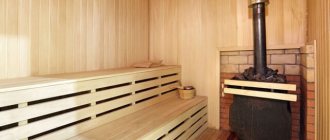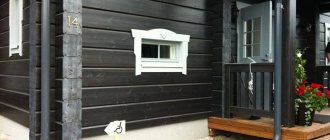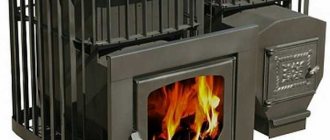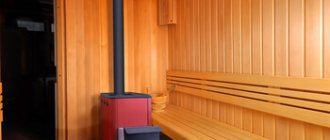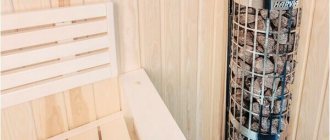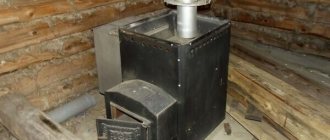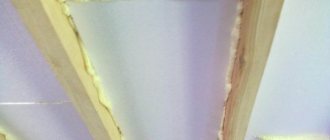Among the huge range of insulation materials for baths, consumers increasingly prefer aluminum foil. This coating is affordable and simple. It perfectly retains heat indoors, eliminating the rapid cooling of the building. This reduces energy costs and guarantees a comfortable stay inside.
Among the main advantages of this material are:
- high fire-resistant qualities;
- good steam and moisture resistance;
- high reflectivity coefficient;
- excellent anti-corrosion properties.
Vapor barrier properties prevent the leakage of hot steam, which then does not accumulate in the coating. Aluminum foil does not deform, does not emit harmful substances or fumes, and is durable and hygienic. The canvases are highly plastic, they are resistant to ultraviolet radiation and are easy to install. They are immune to chemicals and can withstand high temperatures for a long time.
Foil perfectly protects adjacent adjacent rooms if the bathhouse is located inside the house. If installed correctly, even thin sheets will not tear or deform. However, this material must be purchased with a margin of 7%. Bath foil is good because it can withstand temperatures up to 145 °C. Combined with high reflectivity, this property allows you to retain heat inside the steam room for 2.5 hours longer compared to other insulation materials. This provides the effect of a thermos. Thermal insulation is universal in use and is suitable for surfaces that do not require special treatment with fungicidal substances.
Which foil to choose
If you want to decide which bath foil to choose, you should consider several options. Different types of such coatings have special characteristics and properties. For example, “Folgoizolon” is a foil that is applied to polyethylene foam. Thermal insulation is offered in rolls or sheets. Among the advantages should be highlighted:
- high noise insulation properties;
- excellent strength;
- shock-absorbing qualities;
- the possibility of laying the material on a surface without thermal insulation.
Folgoizolon is suitable for log walls and surfaces with slatted lathing. The bases can be covered with clapboard. The thickness of the material reaches 100 mm, and the length and width of the canvas can be 120 cm and 600 mm, respectively. This is true for sheet material, while when it comes to rolls, the thickness varies from 20 to 110 mm, and the length is standard and equal to 25 or 30 m. The width of the roll is also fixed and can be equivalent to 100 or 120 cm.
This bath insulation with foil can withstand temperatures up to 125 °C. Another variety is paper-based foil. This material is also called kraft foil. It is environmentally friendly and can be used on any surface, but the material should be combined with insulation. Sheets can have a thickness from 0.03 to 1 mm. The temperature range here is somewhat narrower and varies from 50 to 85 °C.
Rolled aluminum foil
Foil is produced in both rolls and sheets. Roll material can have a thickness from 0.007 to 0.2 millimeters, a width of 10–1500 millimeters. The percentage of aluminum content in it is up to 99.5%.
Depending on the type of surface, foil is:
- smooth, without additional finishing;
- for finishing;
- finishing
According to the scope of application, the material is divided into canvas:
- food;
- technical;
- tape
Depending on the manufacturing method, foil is distinguished:
- soft (annealed), marked “M”;
- solid (unannealed) – it is assigned the letter “T”.
A quality product is a fabric that has no folds, stains, tears or other inclusions on the surface. When viewing a thin fabric against the light, it should have no tears or tiny holes. Thick foil is allowed to have a small number of holes, which is regulated by the technical parameters of the equipment used.
Thin fabric is wound on bushings having different diameters. Thick foil is produced in sheets.
Before starting insulation work, developers are interested in how much foil for a bathhouse costs. Domestic roll products will cost less than imported material. With a roll length of 25-30 meters, the price will be approximately 20-30 dollars.
Reviews about laminated foil
Another type of foil is laminated aluminum material, which is made by combining polyethylene, paper and foil. As a result, it is possible to obtain a layer that, according to consumers, has high barrier properties.
The fabrics have impressive impermeability to vapor and gases. If we compare with a film, then with a thickness of 9 microns it will have a water vapor throughput of 0.1 g per m2 per day. Buyers like the high hygienic characteristics of laminated foil. In humid conditions, the surface will not create a breeding ground for the development of mytoxins and microflora. It is impossible not to mention elasticity. This material resists compressive loads while maintaining its original shape.
Among the main types of laminated foil, we should highlight kraft paper with foil, which is a three-layer lamination material. Its first layer is kraft paper, the second is thin polyethylene, while the third is aluminum foil itself. Kraft paper is made from long-fiber cellulose by flattening and the use of chemical salts.
According to users, kraft paper is dense, wear-resistant and mechanically strong. As for polyethylene, it has impressive thermoplastic, vapor barrier and water-repellent properties. Foil performs its main function - it reflects heat into the room.
If you purchase Chinese-made material, you will have to pay $26 per sheet. Laminated foil from European manufacturers is more expensive – $45 per sheet. Domestic manufacturers offer foil on kraft paper for $20 per sheet.
Covering the steam room with foil
In order for the foil layer to perform the necessary functions, it is important to carry out the installation work correctly.
- The most comfortable indoor conditions will be ensured by a layer of foil on kraft paper with a thickness of at least 3 mm. Insulation based on basalt reflects well. When planning the installation scheme, it is important to provide for condensate drainage. An overlap of a layer of thermal insulation measuring 150-200 mm will ensure the productivity of the bathhouse, since all seams will be sealed.
- An air layer between the foil backing and the finishing will ensure maximum efficiency. Moreover, this works both on the walls and on the ceiling.
- Well-thought-out ventilation will help create a comfortable microclimate in the bathhouse. If this condition is not met, the insulation layers will become saturated with a large amount of moisture, and all thermal insulation qualities will be lost.
- The “thermos” effect is especially important for a bathhouse at a time when heat is collected indoors. This is ensured by a gap between the layers for ventilation of 1.5-2 cm wide.
- It is important to take into account the proportion of insulation and the material from which the building is constructed. For a brick bath and a wooden steam room, the thickness of the thermal insulation should be different.
Foil for steam room
In a sauna room, foil for a steam room does not absorb warm infrared rays, but reflects the heat produced by the stove. It is this that the human body perceives as heat. Moreover, the tightness of the coating will ensure longer heat retention in the room.
Important! There is an opinion that thermal insulation of a bathhouse can only be done with this insulation. But this is only relevant if the inter-crown gaps are properly caulked. Only then will the foil really increase the heat efficiency of the room.
Structures made of brick and on a frame require additional insulation with mineral or synthetic thermal insulation. Some types of such insulation are covered with foil. The material is popular due to its excellent performance characteristics, among which the most notable are:
- stability: the foil is not subject to deformation due to elevated room temperatures;
- vapor permeability: foil acts as a vapor and hydroprotection for the insulation layer, which significantly increases the period of its use;
- reflective qualities: reflection of 95% of thermal energy helps maintain the required temperature in the bath;
- reducing the amount of time for heating and, as a result, reducing energy costs for heating.
In addition, the walls of the steam room are not covered with condensation, which allows the finish to last much longer and maintain its original appearance.
Simple cladding
Thermal insulation of the log house is done by caulking; additional insulation is not required. However, foil lining is necessary. In such a situation, foil insulation is fixed to walls made of logs or boards. Then the finishing coating is attached on top. The foil pieces are secured with fasteners with the reflective side facing inward. It is necessary to leave an overlap of 20 centimeters. At this stage it is important to comply with the following conditions:
- monitor the integrity of the canvas; if damage is found, it is recommended to cover it with tape;
- It is important to glue the joints of the foil sheets with special tape on a metallized base, this helps ensure tightness;
- a special sheathing is constructed from wooden slats; its direction should be opposite to the installation of the lining;
- material for finishing the room is fixed to the sheathing;
- During installation work with lining, an air layer is maintained between the foil and the finishing layer.
Important! This stage of work is carried out after the final shrinkage of the frame and repeated caulking.
Sheathing over insulation
In bathhouses on frames and brick buildings, foil is fixed to layers of thermal insulation, which are designed to reflect back the heat transmitted by the foil.
To properly organize thermal insulation in such rooms, it is necessary to properly insulate the bathhouse with a layer of foil.
- Before installation work is carried out, a sheathing of slats is constructed on the walls and ceiling, the thickness of which is 5-10 cm (depending on the planned thickness of the insulation layer).
- Insulation (roll or tile insulation) is placed in the cavities between the components of the frame structure. It is better to fix them immediately with temporary slats.
- Then the thermal insulation blocks will need to be fixed to the walls; glassine can be fixed on top.
- Next, aluminum foil is fixed with an overlap of 20-25 cm. First, work is carried out on the ceiling, then on the walls with a slight overlap of the floor.
- The joints are sealed with special tape on a metallized base. This must be done especially carefully in the corners of the room.
- Wooden slats are placed on top of the foil, the thickness of which can be 2-4 centimeters; on the ceiling it is better to use 5 centimeters.
- The foil must be covered with finishing material, while maintaining a gap of the thickness of the lath for convection of air flows.
Important! Thermal insulation made of foil is used not only directly in the steam room, but also in the auxiliary rooms of the structure.
The material is fixed over the entire surface. It is not recommended to neglect the thermal insulation of the ceiling: it is responsible for heat loss, because the warmest air collects at the top.
Characteristics of foil at 100 microns
On sale today is bath foil 100 microns, which is polished and has the form of a roll. Its width is 1 m if we are talking about the hard variety. Annealed foil has a width of 0.5 m. The length reaches 10 m. One roll weighs 2.5 kg.
This bath foil, whose thickness is 0.1 mm, can be used at temperatures up to 650 °C. Its reflectivity is 97%. The material has a smooth surface and can be used in the construction of heated floors, air ducts, furnaces, boilers, as well as for insulation for various purposes. The layer effectively protects against fire, it is resistant to corrosion and retains heat in the coolant.
Such foil in rolls acts as an excellent vapor barrier. It can replace materials such as:
- glassine;
- roofing felt;
- bitumen paper.
The latter release harmful substances when exposed to temperature. Foil can be used as an independent reflective insulator and in combination with other thermal insulation materials. The polished surface is an ideal reflector and improves thermal insulation efficiency.
Operation is possible not only indoors, but also outdoors. This area of use includes insulation of roofs, attics, attics, floors, walls, pipes, ceilings, ventilation, ceilings, water heaters, caravans and wall sections behind heating radiators. This foil acts as solar reflective panels on windows.
Overview of foil thermal insulation
From the information above, it became clear that aluminum foil is used both with and without insulation. In the first case, the foil is applied to the insulation, and in the second - to a beam or log.
On sale you can find:
- Polished aluminum foil according to GOST 618-73 in rolls or sheets
- Foil Kraft Paper
- Insulation with foil layer
Let's look at all the varieties separately, in more detail. The picture shows foil in rolls.
1. Depending on the thickness, foil is sold in sheets or rolls. Annealed (soft) foil is marked in the form of the letter M, and non-annealed foil is marked with the letter T. The thickness of the foil is from 0.007 to 0.2 mm or more, the width is usually 1 - 1.5 m.
Rolls of thin foil most often consist of five pieces of fabric, and thicker ones - of three.
In stores it has a specific purpose - for baths and saunas.
2. Foil paper is a high-strength paper with added cellulose and a thin coating of aluminum. The product is attached to the walls using nails, screws or construction brackets.
It is ideal for insulating building structures in hard-to-reach places.
A roll 1 m wide consists of 30 m of fabric. Price 1 m2 = 420 rub.
This type of coating can withstand temperatures from - 50 to + 120 degrees. WITH
3. This foil insulation is designed specifically for finishing rooms with high humidity.
Penotherm NPP LF is a thermal insulation material made of foamed polypropylene with aluminum foil. It is a reflective insulation as it uses polished aluminum foil. It is mainly used for thermal insulation of walls and ceilings in baths and saunas.
Penotherm NPP LF is easy to cut with a utility knife, can be mounted using a furniture stapler, and glued with tape.
Main characteristics: application temperature from - 50 to + 150 degrees. C, good thermal insulation, good vapor barrier, good sound insulation, does not rot or corrode, environmentally friendly material.
In bathhouses made of bricks or blocks, it is recommended to insulate not only the steam room, but also the sink.
Penotherm NPP LF is produced in different thicknesses and therefore prices will also be different:
- thickness = 2 mm costs 134 rub/m2
- thickness = 3 mm costs 145 rub/m2
- thickness = 4 mm costs 154 rub/m2
- thickness = 8 mm costs 244 rub/m2
- thickness = 10 mm costs 278 rub/m2 (prices are for Perm)
Once again let’s return to point 1 - to aluminum foil in rolls to get acquainted with the prices:
- thickness = 0.04 mm costs 570 RUR/roll
- thickness = 0.08 mm costs 950 rub/roll
- thickness = 0.1 mm costs 200 rub/m2
- thickness = 0.2 mm costs 300 rub/m2
- thickness = 0.8 mm costs 450 rub/m2
Knowing the prices of foil thermal insulation and the material of the walls of your bathhouse, you can compare them with your money and it’s better to choose and buy it.
And when the material is purchased and delivered, you will be able to edit it the way the author of this video did
Thanks to the foil insulation, bathing procedures will be a joy and pleasure. Good luck !
willcomfort.ru
Reviews of foiled mineral wool
Foil-coated mineral wool can be presented in soft rolled and hard mats. According to experts, this expands the scope of use. Among the main advantages of the first of the mentioned types, according to consumers, a high degree of moisture and vapor barrier should be highlighted.
As for foil wool in the form of rigid mats, they have excellent insulating properties and are easy to install. The thickness of soft rolls can reach 10 mm, and the maximum exposure temperature, as home craftsmen emphasize, is quite high and reaches 125 ° C.
The best material for insulating a bath
Since the cost of energy is constantly rising, owners of baths and saunas are forced to look for ways to save costs on operating a steam room. When constructing a new building, it is necessary to use materials that have heat-saving characteristics. Baths built from bricks, foam concrete, cinder blocks and other building materials, except natural wood, need additional protection from heat loss.
When arranging a steam room, you should be especially careful when deciding which foil is best for a bath, since the material must be environmentally friendly and reflect heat well. All these requirements are met by insulation materials with aluminum foil coating.
Advantages of foil insulation:
- The material is universal because it is used for walls, ceilings and bath floors.
- Insulation with foil coating has good light reflection.
- Products are produced in a wide range.
- They are used in damp areas and do not require treatment with fungicidal compounds.
- They have high hygienic indicators. The properties inherent in aluminum do not create a breeding ground for the growth of fungus and mold.
- They do not deform and do not melt in the steam room at elevated temperatures.
- The material is convenient to work with. It is easy to mount and fix on different planes: vertical, horizontal and inclined.
Tips for insulating baths:
- If the bathhouse building does not have a commercial purpose, finishing the walls with 3 mm foil in rolls will be sufficient.
- For commercial enterprises, the solution to the problem of which foil to choose for a bath is the use of laminated products on a basalt mineral base.
When insulating a bathhouse located inside a permanent building, you need to take into account the functioning of central heating, since it additionally heats the air.
banyaspec.com
Reviews of foil in rolls
This material is sold not only in the form of panels. If you want to purchase foil for a bath, you can choose the material in rolls. It is characterized by low cost, which is complemented by ease of installation. Installation of such foil is possible only on fire-resistant heat-insulating material with fastening with metal brackets.
Buyers like that the sheet thickness is minimal and can be 0.5 mm. The roll width is 1500 mm. According to consumers, the temperature range is quite wide and varies from -50 to +75 °C.
Types of insulation with foil for baths
During operation, a thin, soft foil sheet is easily wrinkled and torn, which is why new technologies for its use have emerged.
Currently on sale:
- foil paper;
- textile;
- insulation.
Foil paper
Its other name is laminated foil on a paper base for a bath. It is an elastic and dense material and has excellent vapor barrier properties. It is produced in two types: foil plus kraft paper and foil plus paper plus polyethylene.
Foil paper can withstand 130-degree heat. Resists compressive loads. It holds its shape and is easy to cut. The standard strip width is 120 centimeters. Self-tapping screws, construction staples and nails are used to secure it. The material is used for lining the inside of baths. It is not recommended to use laminated foil on the surface of walls adjacent to the stove.
Foil fabric (foil fabric)
This soft two-layer material is made from fiberglass and foil. The thickness of the foil fabric is in the range of 0.12–3 millimeters. The panels need to be fastened end-to-end. Foil fabric is used to insulate bathhouses; it can be used to sheathe walls near the heating unit.
Its main characteristics:
- ability to withstand temperatures up to 500 degrees;
- resistance to mold and other harmful microorganisms;
- good moisture resistance.
Foiled polystyrene foam
The insulation is made from expanded polystyrene and covered with a thin layer of aluminum foil. The material is produced in sheets measuring 1.2 x 0.6 meters with a thickness of 2-10 centimeters. They are used to insulate the premises of a bathhouse building from the inside. The sheets are equipped with stepped locks that prevent the formation of cold bridges.
Foiled polystyrene foam has the following qualities:
- does not absorb moisture;
- reflects about 98% of thermal energy;
- differs in vapor barrier properties;
- resistant to chemical influences;
- safe for health;
- has a long service life.
Foil polyethylene foam
This roll insulation with a thickness of 2 to 10 centimeters has a one-sided or double-sided foil coating. It is used when arranging thermal insulation for the interior of baths.
This material can withstand temperatures of no more than 100 degrees. It is not used for covering surfaces near the stove.
Foil mineral wool
It is produced in rolls or in the form of mats of different thicknesses. Has excellent thermal insulation properties. Ideal for insulating frame bath buildings. The use of rolls or mats with foil makes finishing work easier and more convenient.
Additional properties of polystyrene foam with a foil layer
This material is combined and consists of polyethylene foam with a closed porous structure. It is supplemented with aluminum foil. The canvases are used as noise insulation and thermal protection material for interior and exterior work. The combination of these layers allows for economical and efficient finishing of baths and saunas. Among the main properties it is worth highlighting:
- shock-absorbing qualities;
- health safety;
- vapor barrier properties;
- ability to reflect heat up to 98%;
- long working life;
- chemical resistance.
Advantages of the material
Taking into account the peculiarities of operation and the microclimate of the bathhouse premises, a number of requirements are imposed on the foil used:
- good moisture, steam and water resistance;
- high fire-resistant qualities;
- good anti-corrosion properties;
- high reflectivity coefficient (within 95-98%), achieved through special polishing of the top layer;
- significant thermal conductivity.
Excellent vapor barrier properties help prevent the leakage of hot steam from the room, which will not accumulate in the coating. In addition, aluminum foil has the following advantages:
- complete absence of deformation and loss of original consumer properties;
- high plasticity of the coating under prolonged exposure to high temperatures;
- no emission of substances and fumes harmful to humans;
- UV resistance;
- protection against excessive condensation, mold and pathogenic microorganisms;
- ease of installation;
- durability;
- hygiene;
- resistance to chemical reagents;
- protection of adjacent or adjacent rooms if the bathhouse is located inside the house.
With careful installation, even thin paper-based sheets will not tear or deform. But you should remember that you should buy such material with a small margin of 5-7%.
Aluminum foil can withstand temperatures up to 145 °C, which, combined with high reflectivity, helps retain heat inside the steam room for 2-2.5 hours longer compared to other insulation materials, providing the so-called thermos effect. This is a universal insulation material suitable for walls, floors and ceilings of steam rooms, baths and saunas and does not require special treatment of the premises with fungicidal substances.
Selecting a foil coating based on the recommended layer
In order to achieve high-quality coverage during installation work, you should adhere to the thickness of the foil thermal insulation. It will depend on the material and thickness of the wall. If the base is brick and the thickness of the steam room wall reaches 37 cm, then the recommended layer should be from 8 to 10 mm. If the base is concrete or brick, and the wall thickness varies from 25 to 35 cm, then the foil insulation should have a thickness of 10 to 12 mm. In the case of a wooden frame from 10 to 15 cm, you must use foil thermal insulation, the thickness of which varies from 6 to 8 mm.
When using the same material, but increasing the wall thickness to 20 cm, you should use a foil layer from 4 to 6 mm in thickness. Foil for a bath will have a layer of 2 to 4 mm if the wooden frame is more than 20 cm thick.
Glass wool or basalt wool can be used as an additional heat-insulating layer. Similar mineral heat insulators are also suitable. Aluminum foil or similar coatings will reflect heat into the room, so it is better to install such a layer in a steam room insulated like a pie. This recommendation is relevant for saunas and baths made of concrete or brick. The advice is also suitable for frame buildings. If the external walls of wooden log houses are sufficiently thick, the layer of additional thermal insulation can be neglected, but when choosing a foil material, you should not give preference to thin sheets of kraft paper in foil.
When is it needed and when is it not?
It is not needed by those bathhouse owners for whom neither fuel economy nor long-term heating are a problem.
It is also not needed by those who completely deny its ability to reflect infrared radiation through a layer of lining, but believe that the thermal conductivity of aluminum is a guarantee of rapid cooling of the bath precisely with the help of foil.
There is no need for it either if the bathhouse is sufficiently insulated using traditional methods, and its heating and cooling completely suits the owner.
It is wrong to assume that it will not find application in bathhouses made of logs or timber, since in wooden buildings only proper insulation of the crowns and high-quality sealing of all cracks is required. If desired, you can insulate any bathhouse. Let this be a repetition, but foil is needed where time and effort are valued.
Useful video
However, despite the above, there is an opinion that the absence of foil makes vaping softer, eliminating the sharp water hammer during paired procedures:
Installation technology
When installing foil for a bath, you must follow the tips that will allow you to achieve the effectiveness of the coating and a comfortable stay in the steam room. When it has an impressive area, you can use basalt or mineral based foil. When laying material in a non-commercial bathhouse, it is sufficient to use kraft paper in foil or rolled foil. The thickness of the material should be 3 mm or more.
When locating a bathhouse inside a house or in a basement, you need to take into account central heating and the location of its sources. In this case, such a system will act as additional air heating.
When finishing a bath with foil, it is important to provide for condensate drainage. In this case, the canvas is displayed on the walls and floor. The foil material should be laid with an overlap of 20 cm and taped with foil tape. In order to ensure the effect of a thermos, a 15 mm gap must be placed between the foil coating and the decorative cladding. It will provide ventilation and guarantee a healthy microclimate.
Performing a simple bath lining
When covering the walls of bath buildings, the foil sheet is attached to the surface or on top of a layer of thermal insulation. This work will take little time and will not require much effort.
The process looks like this:
- Before covering the bathhouse with foil, a frame made of wooden planks is fixed to the wall.
- Insulation is placed between the slats.
- The top of the heat-insulating material is covered with overlapping foil, the joints between the strips are glued using aluminum tape.
- The foil is sheathed with clapboard and a 15-20 cm air gap is required between it and the surface of the foil. This is a prerequisite for effective heat transfer.
The air gap will reduce the thermal conductivity of aluminum, and since the hot lining will not come into contact with the foil, due to the insulating properties of the air, direct heat transfer will become impossible. At the same time, infrared rays hitting the surface of the foil sheet will be reflected towards the steam room.
Foil installation algorithm
If you are interested in how to attach foil in a bathhouse, you should know that the process is divided into several stages. The most convenient to work with will be sheets or rolls, the width of which is 60 cm or 1.2 m. It is necessary to make lathing on the walls. For this, square beams with a side of 5 cm are used.
A distance is maintained between adjacent planks, which depends on the width of the material. If the work uses rolls of 600 and 1200 mm, then the step will be 60 cm. For foil materials with a width of 1000 and 1500 mm, the distance between the bars will be 50 cm. The bars are fastened with self-tapping screws of a suitable length. Between the slats there is a layer of mineral insulation so that it does not protrude beyond the level of the beams.
After you have decided which foil is best for the bath in your case, it should be strengthened on top of the thermal insulation with the obligatory placement of a reflective layer inside the steam room. The joints of sheets and canvases are glued with metal tape. But it is important to take into account that under the influence of temperatures, the glue can soften, which will contribute to the divergence of the canvases and failure of the seal. It is better to fix it with nails or staples, nailing them onto the beams.
With an impressive width, the foil material is attached not only at the edges, but also in the center. The foil for the walls of the bathhouse is sewn up with clapboard. An air pocket of 0.5 cm should be left between these layers. Its main function is to reduce the thermal conductivity properties of the foil and reflect the rays that hit its surface. The air gap will be created by lathing under the lining. For this, 20 mm strips are selected, which are fastened with self-tapping screws.
In some cases, the order of the materials changes. In this case, a layer of foil is stuffed onto the layer of thermal insulation between the sheathing beams with nails or staples, which is attached on top with thin slats. They should be located on top of the sheathing.
Sometimes the frame is stuffed over thermal insulation. In this case, the foil is laid over the entire area of the wall, as well as on the beams. Leaving an air gap in this case is impractical. Fastening the lining using this technology is carried out on the sheathing. Practice shows that the use of heat-insulating materials with a layer of foil saves money and simplifies the installation process.
Using foil to insulate baths
To determine which foil to use for a bathhouse is better, you need to take into account what material the structure is built from and the conditions of its operation. If the building is made of logs with carefully caulked walls, then it does not require foil insulation.
In the case where the bathhouse is built of natural wood, but is large in area and does not heat up well, experts recommend lining the ceiling and walls from the inside with thin foil, and then covering it with clapboard. You can use a foil sheet for the surface behind the heating unit, as a result of which the steam room will warm up faster.
Despite the fact that a bathhouse made of foam concrete is considered warm, it requires high-quality vapor barrier, so the use of foil will be justified, but it is better to opt for laminated products.
Frame and brick buildings must be insulated. Insulation for a bathhouse with foil based on polystyrene foam and mineral wool is ideal for this (read: “How to insulate a frame bathhouse - nuances from the master”). The type of this material is selected for ceilings taking into account the thickness of the ceiling and the absence/presence of thermal insulation in the attic.
In addition, operating conditions matter. If the bathhouse is used infrequently and the procedures are not carried out for long, there is no need to insulate it with foil. When the steam room is used frequently and is kept in it for a long time, high-quality thermal insulation will save fuel, and the room will quickly warm up and cool down for a long time.
Installation of foil on the ceiling
After reading reviews about bath foil, you can understand that it has a wide range of uses. It can be installed not only on walls, but also on the ceiling. To do this, it is covered with rolled paper with wide overlaps. At the next stage, the paper is fixed with square bars with a side of 5 cm. Insulation is installed between them.
The next step is to install the foil. She will close the insulator. It is important to ensure 100% solidity. Fastening is carried out with adhesive tape, which can be purchased at a hardware store. Quite often it is implemented together with foil.
Among such tapes there are low-quality ones. Checking this is quite simple: you need to glue a piece of material to a piece of foil and try to tear it off. If you have ordinary tape in your hands, then the task will not be so easy. If you want to know in detail how to sheathe the inside of a bathhouse with foil, then the edges and joints must be carefully fixed. This is necessary to prevent moisture penetration. It is important to achieve tightness.
Instead of aluminum foil, you can use wax paper or thick cardboard. It is pre-impregnated with drying oil. But on such a vapor barrier it will be necessary to lay a layer of clay, only then can insulation begin. The foil is fixed with bars with a cross section of 2 x 3 cm. This will allow you to maintain air exchange, and in the future you can install decorative trim on the bars.
Performance properties of foil
First you need to choose the right type of foil. You cannot use its food analogue, since the material has low strength. For baths, technical varieties are used with a thickness of up to 300 microns. But it is not installed on the walls either - thermal insulation materials are additionally installed.
The foil is made of aluminum, which determines its performance properties:
- does not corrode, which is important for rooms with high humidity;
- can take different shapes, bends easily;
- does not allow water to pass through;
- reflective properties - most of the thermal radiation returns back to the steam room.
To equip a bathhouse, aluminum foil is used in combination with other materials. Despite its advantages, it does not have heat-insulating properties, which is a prerequisite for a steam room.
Methods for attaching panels to walls
Using nails or self-tapping screws is the traditional option for attaching panels to walls. A more modern method is the use of clamps. It does not damage the panels, but requires additional costs of both time and money when installing the lining.
Using nails or screws
This method will require a screwdriver or hammer, as well as special nails or self-tapping screws - galvanized or made of copper alloy. Such fittings are more expensive, but if you save on them and buy ordinary nails, they will begin to rust over time. This will lead to the appearance of red streaks on the lining, which will spoil the appearance of the finish and stain the skin and things when touched. The fasteners are driven or screwed into the lining tenon at an angle of 45 degrees. The fastening points will have to be sanded so that there are no burrs or other defects left. The disadvantage of this method is that holes will have to be created on the planks when fastening them with nails. And when you try to remove the lining, the fastening points will be further damaged, which precludes the reuse of the panels if necessary.
Fastening with clamps
Do-it-yourself installation using clamps is safe for lining strips because it does not damage them. A clamp is a special bracket that is attached to the lower half of the lining groove - a recess into which the tenon of the next plank is inserted. The fastenings of the bracket are covered with the next strip in the row. Fixing the staples to the sheathing beams is carried out with nails or self-tapping screws.
With this installation method, the lining is not damaged, and there are no nail heads or screws left on the outer surface of the cladding, which eliminates the risk of getting burned or getting a rusty drip on your clothes after visiting such a bathhouse.
It is also easier to partially replace the lining mounted in this way - just pull the boards out of the grooves and pull out the fasteners. If you do not work carefully, it will be the staples that are damaged, not the boards.
We recommend reading:
Fiber optic bath lighting
